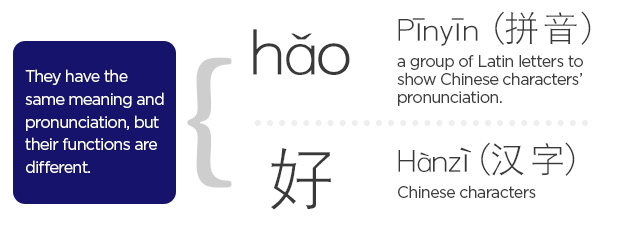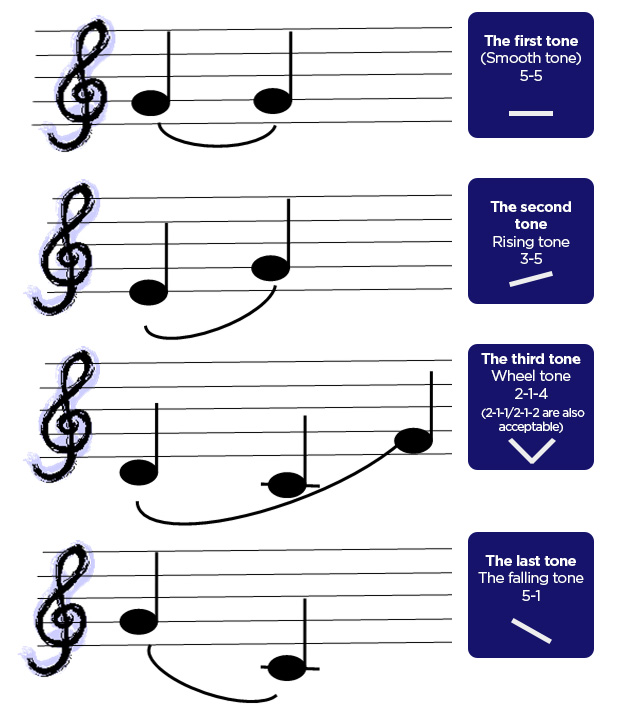My name is Xiaoming. I teach Chinese pronunciation to English speakers.
First we should get to know something about Chinese. The Chinese language can be divided into two parts. One is the letters we use to show the pronunciation and the other is what is called Chinese Characters. Here is an example.

A syllable like hǎo can be separated into three parts:

Most vowels are pretty easy for English speakers, but they may face more problems in learning initials. Most finals are vowels expect –n and –ng.
Chinese Vowels easiest easy hard hardest (read in this way)
| Chinese finals | How to pronounce in English |
| ɑ | hug[V] |
| o | organization[O] |
| e | teacher[E] |
| i | e-book[i] |
| u | book[u] |
| ü | Circle your mouth and say [i:] |
| -i(R) | |
| -i(S) | |
| ê | yes[e] |
| ɑi | iPhone[ai] |
| ei | hay[ei] |
| ui(uei) | oui [uei] |
| ɑo | how[Ao] |
| ou | ghost[Eu] |
| iu(iou) | you[iEu] |
| ie(iê) | yes[ie] |
| üe(üê) | |
| er | teacher[Er] |
| ɑn | Hen[en] |
| en | Written[En] |
| in | Bingo[in] |
| un(uen) | when[uEn] |
| ün(üen) | |
| ɑng | yuong[AN] |
| eng | [EN] |
| ing | bing[iN] |
| ong([uN]) | [uN] |
| iɑ | Australia[iA] |
| uɑ | [uA] |
| uo | [uo] |
| uɑi | why[uAi] |
| iɑo | [iAo] |
| ian | [ien] |
| iang | young[iAN] |
| uan | [uen] |
| uang | want[uAN] |
| ueng | [uEN] |
| iong(üng) | |
| üan |
22/39 56.41% 11/39 28.21% 4/39 10.26% 2/39 5.13%
According to the chart above, Chinese finals are pretty easy, right?
In fact Chinese initials are not difficult, but learners may make
similar mistakes in different initials.
All the Chinese initials are consonants of only four Voiced sounds, they are m, l, n, and r most unvoiced sounds in Chinese are Voiced in English, so students may be confused with two initials such as b and p. They may think or pronounce them in the same way, you need much practice to make differentiate them. There are also some initials with no similar pronunciations in English. You can see them in the following chart.
Chinese Initials easy normal hard hardest
N=not Y=yes
| Initials | Voiced? | Aspirated? | Similar pronunciation in English |
| b | N | N | Papa in French |
| p | N | Y | please |
| m | Y | N | mama |
| f | N | Y | fox |
| d | N | N | Type in French |
| t | N | Y | tyre |
| n | Y | N | noon |
| l | Y | N | look |
| g | N | N | Qui in French |
| k | N | Y | kite |
| h | N | Y | hey |
| j | N | N | gee |
| q | N | Y | |
| X | N | Y | |
| zh | N | N | |
| ch | N | Y | choose |
| sh | N | Y | English |
| r | Y | N | rich |
| z | N | N | friends |
| c | N | Y | cats |
| s | N | Y | study |
10/21 47.62% 6/21 28.57 3/21 14.29% 2/21 9.52%
Chinese is a language with different tones. There are just few languages with tones such as Chinese, Tibetan, and Vietnamese. There is a key to learn Chinese tones: sing them out loud! Just play the music according to the following music score and sing with it.

As for the soft tone, you should just lengthen the word before the soft tone and then read the syllable with the soft tone very shortly and softly:

Chinese is not easy, but it also is not that difficult, right?
Some useful daily Chinese expressions:
你好! Nǐ hǎo! Hello! かんにちは!
谢谢! Xièxie! Thank you! ありがとう ございます!
不客气! Bú kèqi. You are welcomeいいえ、どうたしました!
对不起! Duìbùqǐ I’m sorry!/Excuse me! すみません!
没关系。 Méi guānxi That’s all right.構うことはない。
多少钱? Duōshǎo qián How much? いくらですか?
再见! Zàijiàn! Goodbye! さようなら!
I will write another article on Japanese speakers
learning Chinese pronunciation. Later I will post some useful exercises
for practicing Chinese pronunciation.
Xiaoming Wang, LOS Consultant
